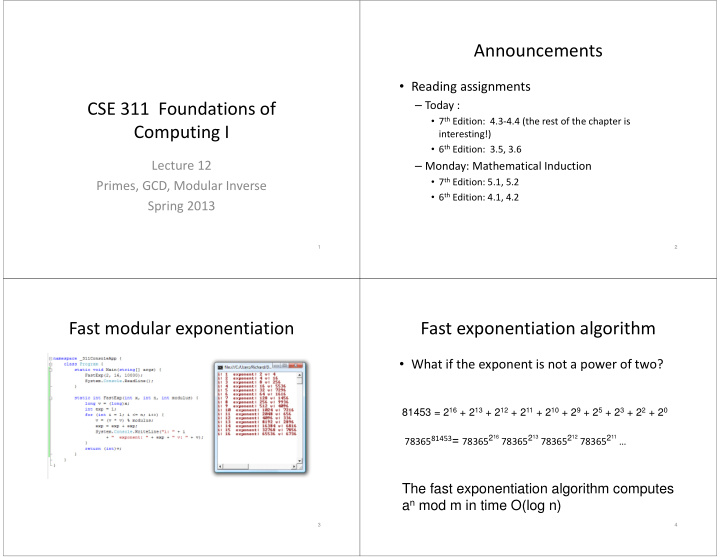



Announcements • Reading assignments – Today : CSE 311 Foundations of • 7 th Edition: 4.3-4.4 (the rest of the chapter is Computing I interesting!) • 6 th Edition: 3.5, 3.6 Lecture 12 – Monday: Mathematical Induction • 7 th Edition: 5.1, 5.2 Primes, GCD, Modular Inverse • 6 th Edition: 4.1, 4.2 Spring 2013 1 2 Fast modular exponentiation Fast exponentiation algorithm • What if the exponent is not a power of two? 81453 = 2 16 + 2 13 + 2 12 + 2 11 + 2 10 + 2 9 + 2 5 + 2 3 + 2 2 + 2 0 78365 81453 = 78365 2 16 78365 2 13 78365 2 12 78365 2 11 … The fast exponentiation algorithm computes a n mod m in time O(log n) 3 4
Fundamental Theorem of Primality Arithmetic An integer p greater than 1 is called prime if the Every positive integer greater than 1 has a only positive factors of p are 1 and p . unique prime factorization A positive integer that is greater than 1 and is not 48 = 2 • 2 • 2 • 2 • 3 prime is called composite . 591 = 3 • 197 45,523 = 45,523 321,950 = 2 • 5 • 5 • 47 • 137 1,234,567,890 = 2 • 3 • 3 • 5 • 3,607 • 3,803 5 6 Factorization Euclid’s theorem If n is composite, it has a factor of size at There are an infinite number of primes. most sqrt(n) Proof: By contradiction Suppose there are a finite number of primes: p 1 , p 2 , . . ., p n 7 8
Distribution of Primes Famous Algorithmic Problems 2 3 5 7 11 13 17 19 23 29 31 37 41 43 47 53 59 61 67 71 73 79 83 89 97 101 103 107 109 113 127 131 137 139 149 151 157 163 167 173 • Primality Testing: 179 181 191 193 197 199 211 223 227 229 233 239 241 251 257 263 269 271 277 281 283 293 307 311 313 317 331 337 347 349 353 359 – Given an integer n, determine if n is prime • If you pick a random number n in the range • Factoring [x, 2x], what is the chance that n is prime? – Given an integer n, determine the prime factorization of n 9 10 Factoring 123018668453011775513049495838496272077285356959 533479219732245215172640050726365751874520219978 646938995647494277406384592519255732630345373154 • Factor the following 232 digit number 826850791702612214291346167042921431160222124047 9274737794080665351419597459856902143413 [RSA768]: 334780716989568987860441698482126908177047949837 12301866845301177551304949583849627 137685689124313889828837938780022876147116525317 20772853569595334792197322452151726 43087737814467999489 40050726365751874520219978646938995 64749427740638459251925573263034537 367460436667995904282446337996279526322791581643 31548268507917026122142913461670429 430876426760322838157396665112792333734171433968 21431160222124047927473779408066535 10270092798736308917 1419597459856902143413 11 12
Greatest Common Divisor GCD and Factoring a = 2 3 • 3 • 5 2 • 7 • 11 = 46,200 • GCD(a, b): Largest integer d such that d|a and d|b b = 2 • 3 2 • 5 3 • 7 • 13 = 204,750 – GCD(100, 125) = GCD(a, b) = 2 min(3,1) • 3 min(1,2) • 5 min(2,3) • 7 min(1,1) • 11 min(1,0) • 13 min(0,1) – GCD(17, 49) = – GCD(11, 66) = Factoring is expensive! – GCD(13, 0 ) = Can we compute GCD(a,b) without factoring? – GCD(180, 252) = 13 14 Useful GCD fact Euclid’s Algorithm Repeatedly use the GCD fact to reduce numbers If a and b are positive integers, then until you get GCD(x,0)=x gcd(a,b) = gcd(b, a mod b) GCD(660,126) Proof: By definition a = ( a div b ) b + ( a mod b ) If d| a and d| b then d|( a mod b ): If d| b and d|( a mod b ) then d| a : 15 16
Euclid’s Algorithm Bézoit’s Theorem Example: GCD(660, 126) • GCD(x, y) = GCD(y, x mod y) If a and b are positive integers, then there exist integers s and t such that int GCD(int a, int b){ /* a >= b, b > 0 */ gcd(a,b) = sa + tb . int tmp; int x = a; int y = b; while (y > 0){ tmp = x % y; x = y; y = tmp; } return x; } 17 18 Extended Euclid’s Algorithm Multiplicative Inverse mod m • Can use Euclid’s Algorithm to find s , t such that Suppose GCD(a, m) = 1 sa + tb =gcd( a , b ) • e.g. gcd(35,27): 35 = 1 • 27 + 8 35 - 1 • 27 = 8 By Bézoit’s Theorem, there exist integers s and t 27= 3 • 8 + 3 27- 3 • 8 = 3 such that sa + tm = 1. 8 = 2 • 3 + 2 8 - 2 • 3 = 2 3 = 1 • 2 +1 3 - 1 • 2 = 1 2 = 2 • 1 +0 s is the multiplicative inverse of a: 1= 3 - 1 • 2 = 3 – 1 (8 - 2 • 3) = ( -1 ) • 8 + 3 • 3 =(- 1 ) • 8 + 3 (27- 3 • 8 ) = 3 • 27 + ( -10 ) • 8 1 = (sa + tm) mod m = sa mod m = 19 20
Solving Modular Equations Multiplicative Cipher: f(x) = ax mod m Solving ax ≡ b (mod m) for unknown x when For a multiplicative cipher to be invertible: gcd(a,m)=1. f(x) = ax mod m : {0, m-1} → {0, m-1} must be one to one and onto 1. Find s such that sa+tm=1 2. Compute a -1 = s mod m, the multiplicative Lemma: If there is an integer b such that inverse of a modulo m ab mod m = 1, then the function f(x) = ax mod m 3. Set x = (a -1 • b) mod m is one to one and onto. 21 22
Recommend
More recommend